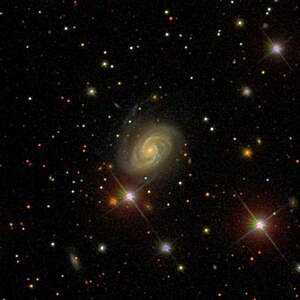NGC 6898
| Galaxy NGC 6898 |
|
|---|---|

|
|
| SDSS recording | |
| AladinLite | |
| Constellation | Capricorn |
|
Position equinox : J2000.0 , epoch : J2000.0 |
|
| Right ascension | 20 h 21 m 08.0 s |
| declination | -12 ° 21 ′ 32 ″ |
| Appearance | |
| Morphological type | (R ') SB (rs) a: / HII |
| Brightness (visual) | 13.6 mag |
| Brightness (B-band) | 14.5 mag |
| Angular expansion | 1.20 × 0.7 |
| Position angle | 140 ° |
| Surface brightness | 13.3 mag / arcmin² |
| Physical data | |
| Redshift | 0.019170 ± 0.000037 |
| Radial velocity | 5747 ± 11 km / s |
|
Stroke distance v rad / H 0 |
(262 ± 18) · 10 6 ly (80.3 ± 5.6) Mpc |
| history | |
| discovery | Albert Marth |
| Discovery date | June 28, 1863 |
| Catalog names | |
| NGC 6898 • PGC 64517 • MCG -02-52-002 • IRAS 20183-1231 • 2MASX J20210802-1221320 • LDCE 1389 NED006 | |
NGC 6898 is a spiral galaxy with extensive star formation regions of the Hubble type Sa in the constellation Capricorn on the ecliptic . It is estimated to be 262 million light-years from the Milky Way and about 95,000 light-years across . It probably forms a gravitationally bound pair with NGC 6897 .
The object was discovered by Albert Marth on June 28, 1863 .
